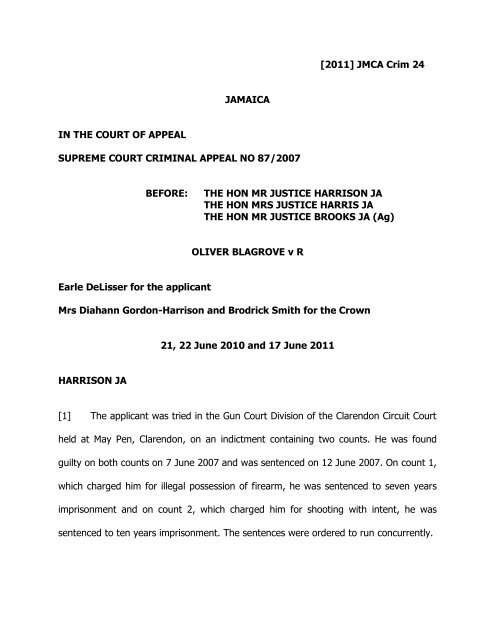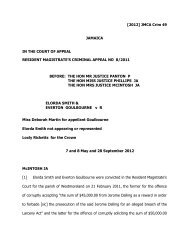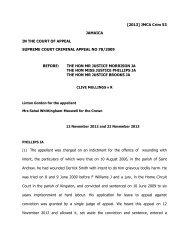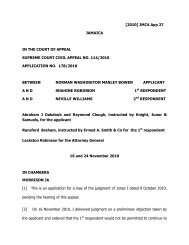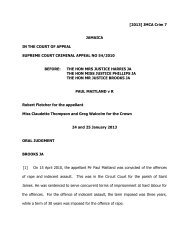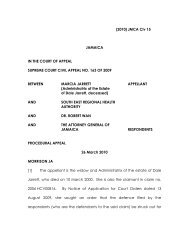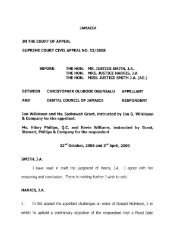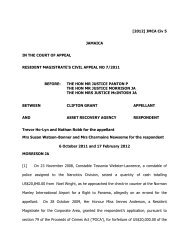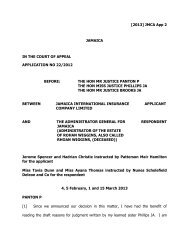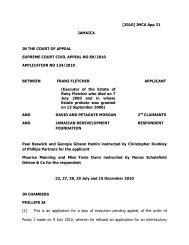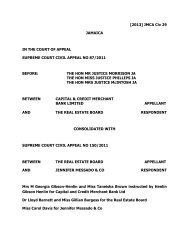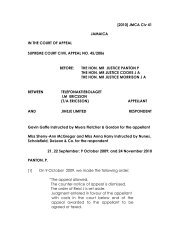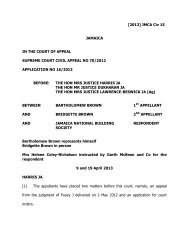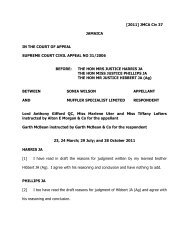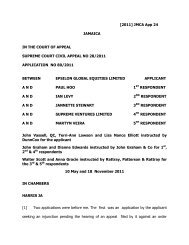Blagrove (Oliver) v R.pdf - The Court of Appeal
Blagrove (Oliver) v R.pdf - The Court of Appeal
Blagrove (Oliver) v R.pdf - The Court of Appeal
You also want an ePaper? Increase the reach of your titles
YUMPU automatically turns print PDFs into web optimized ePapers that Google loves.
[2011] JMCA Crim 24JAMAICAIN THE COURT OF APPEALSUPREME COURT CRIMINAL APPEAL NO 87/2007BEFORE:THE HON MR JUSTICE HARRISON JATHE HON MRS JUSTICE HARRIS JATHE HON MR JUSTICE BROOKS JA (Ag)OLIVER BLAGROVE v REarle DeLisser for the applicantMrs Diahann Gordon-Harrison and Brodrick Smith for the Crown21, 22 June 2010 and 17 June 2011HARRISON JA[1] <strong>The</strong> applicant was tried in the Gun <strong>Court</strong> Division <strong>of</strong> the Clarendon Circuit <strong>Court</strong>held at May Pen, Clarendon, on an indictment containing two counts. He was foundguilty on both counts on 7 June 2007 and was sentenced on 12 June 2007. On count 1,which charged him for illegal possession <strong>of</strong> firearm, he was sentenced to seven yearsimprisonment and on count 2, which charged him for shooting with intent, he wassentenced to ten years imprisonment. <strong>The</strong> sentences were ordered to run concurrently.
<strong>The</strong> Case for the Prosecution[2] <strong>The</strong> two main witnesses for the prosecution were dead at the time <strong>of</strong> trial sotheir statements were tendered pursuant to section 31D (a) <strong>of</strong> the Evidence Act. <strong>The</strong>ywere admitted and read into evidence as exhibits 1 and 2 respectively.[3] Kirk Miller, a bus conductor who lived at 35 ½ Evan Street, Denbigh, Clarendon,stated as follows:“Paul <strong>Blagrove</strong>, otherwise called 'Screechie' o/c'One Time', the owner <strong>of</strong> a Hiace mini bus, ply theroute, May Pen, Spanish Town, and Mandeville. Ihave been conducting this bus for about threemonths, it is been driven by a man by the name <strong>of</strong>David from Longville, in the parish <strong>of</strong> Clarendon.Paul <strong>Blagrove</strong> is well known to me, we grow up in theEvan Street and Lewis Street area. We used to playfootball together. Paul's mother's name is Miss Lucile. Hisfather, now deceased, was called, Mass Jimmy. He hastwo brothers. <strong>The</strong>y are called Benfoot, and Jimmy. WhenPaul was about in his twenties, he migrated about sixyears. He returned to Jamaica, he started the business <strong>of</strong>operating the mini bus. On his return, we continue ourrelationship, Paul presently lived with his wife, and otherfamily members at Evan Street near to Paradise andLewis Street. I can stay where I live and look acrossParadise Street and Lewis Street. I live with my girlfriend,Tamara Cooper, our house, is a one apartment andstructure <strong>of</strong> board, zinc ro<strong>of</strong>, it had two windows made <strong>of</strong>plain glass louvre blade, the windows are situated, oneto the left side as one faces the front <strong>of</strong> the house, theother to the verandah.It has two doors, one to the back and the other to the frontleading from the verandah. <strong>The</strong> front door is equippedwith night clock and power bolt, the back doors equippedwith one tower bolt. <strong>The</strong> house is equipped with electricity
lights. I obtained the light from my sister's house, she ismy neighbour. <strong>The</strong>re are three outside light bulbs, lightsare placed as follows: One on the verandah, one on the left,as one faces the front, and one on a piece <strong>of</strong> rafterfacing the road. All the bulbs are working. My house isabout a chain or less from the road. About three weeks upto Sunday, the 2nd day <strong>of</strong> July, 2006, David and Ioperate a bus, we did not get our pay, Paul told us to workthe bus on Sundays and pay ourselves, and full the tankwith gas oil for Monday morning. On Sunday the 2nd,David and I ply the road from May Pen to Frankfield, Ipurchase $5000.00 gas oil and obtained a receipt.Sometime about midday, we came home we went to Paul<strong>Blagrove</strong> home. I told him what happened, hedisputed the amount <strong>of</strong> gas oil I purchased. I gave him$1000.00, he began saying that I robbed him and evenin the police station. He said I am talking to him too long,a kill he should kill me, and say I should pass up hismoney. He said I am talking to him too long, a kill heshould kill me. I saw him went to his house, I becamefearful and ran to my home. I went into my houseabout fifteen minutes, I was inside my house, when Iheard Paul‟s voice calling me, at that time, I hadturned <strong>of</strong>f all the lights, I looked through the frontwindow, I saw Paul standing at the gate with amachete in his hand, David opened the gate, came inthe yard and also called out my name. I did notanswer, when I heard the driver said, it sound like himnuh deh there, both man (sic) left. On Mondaymorning, I did not return. I received a call from thedriver, via cell phone, saying that Paul wanted to killme. On Thursday the 6 th day <strong>of</strong> July, 2006 at about 10pm, my girlfriend Cooper and I went inside our house,and I securely locked up the doors and windows. Iturned on the lights about 11:10 pm. I was seated onthe bed."While I was eating, I heard a loud explosion, I sawsomething pass me. I heard a rattling sound. I look and sawsmoke coming from a bucket, I got up and look through thefront window, I saw Paul <strong>Blagrove</strong> and another man, I knowas 'Blacks', and I saw Paul had a black gun in his right hand.He pointed it in the direction <strong>of</strong> my house, I then heard twomore explosions. I saw blue flames coming from the mouth
<strong>of</strong> the gun. I still look through the window, I saw when hepointed it in the air and fired several shots and I saw flamescoming from it. I… he then left. I was able to recognize himboth from the electricity light shining from the outside pubbulb. Paul was a dreadlocks, he -- his head was not covered.He was dress (sic) in white merino and jeans pants. I couldsee his face clearly. 'Blacks' was dressed in jeans jacket andjeans pants. 'Blacks' is <strong>of</strong> black complexion, about five feet 4inches tall, mean face, small head, low cut hair, round facewith a scar. I don't remember which size really he is <strong>of</strong>,medium built. Blacks live at Beckford Street in thevicinity <strong>of</strong> Evan's Street and Lewis Street. I knowBlacks from about January <strong>of</strong> this year. I know hishome, I know the people who will go live there but Idon't know the names; I met Blacks at Paul<strong>Blagrove</strong>'s home. We speak to each over. I last spoketo Blacks on Sunday the second <strong>of</strong> July 2006. I amcertain that the men I saw were Paul <strong>Blagrove</strong> andBlacks. <strong>The</strong> light were shining very bright, that I with(sic) facing the house, I saw their faces for abouteight minutes when the men left at fifteen minutesafter my girlfriend and I left to the payment placeand made a report to the police. I took the police tomy home, Friday the seventh day <strong>of</strong> July, 2006. Igave a statement to the police. It was read over tome and I sign my name as correct. This statementconsisting <strong>of</strong> five pages signed by me, is true andcorrect to the best <strong>of</strong> my knowledge and belief and Imake it knowing that if it is tendered in evidence Ishall be liable to prosecution if I had wilfully stated init anything that I know to be false, I do not believeto be true. Statement recorded by me on the seventh <strong>of</strong>July, 2006 at 2:00 a.m.” [Pages 81-86 <strong>of</strong> the transcript][4] Tamar Cooper, who was 29 years <strong>of</strong> age and was unemployed, statedinter alia:“I am living at the above mentioned address with mycommon-law husband, Kirk Miller for the past six months. Welive in a one bedroom board-house with two windows, one tothe front and one at the side. <strong>The</strong>re is two doors, one at thefront and one at the back. <strong>The</strong> window are however made
from glass, on Thursday the 6th <strong>of</strong> the 7th, 2006, about11:10 p.m., Kirk and I were at home when he was about tohave his dinner. I then heard someone call Kirk, Iimmediately recognized the voice to be that <strong>of</strong> a man knownas Hall, otherwise called Screechy. I turned to Kirk and saidScreechy is calling you, are you not going to answer him andhe said that I should keep quiet, and look through thewindow. As I look through the window I saw Screechy andthree other men, one <strong>of</strong> them I know only as Blacks fromBeckford Street. When I looked through the window I sawScreechy holding a gun in his hand pointing toward thehouse. I saw when he turned to Blacks and say something. Iwas able to see all <strong>of</strong> this because it was a glass window andit was transparent, and allow me to see through whereScreechy and the men, were. Where Screechy and the menwere, was well lit with electric bulb from ourneighbour's house which is very close to ours whichis about 16 feet apart. Two lights from our house,and the outside were on. <strong>The</strong> light inside my housewas on, and as I look through the window I sawwhen Screechy fired three shots in our house. I wasable to see flashes <strong>of</strong> light from where Screechy was.Immediately, I fell to the ground and I saw Kirkstanding at the back door between the stove and Iwas lying on the floor, I heard several shots. I stoodthere for about fifteen minutes. <strong>The</strong>n Kirk and I openthe front door and we came out, and turn on all <strong>of</strong>the lights on the outside. We then both walked out atthe gate and I saw a man who asked me what wasgoing on because they heard the shots and sawScreechy. We then walked to the station and madethe report. I know Screechy since February <strong>of</strong> thisyear, I see him two weeks. Kirk was working forscreechy who owns a bus name One Time. Kirk wasthe conductor on this bus. I also know Blacks, heabout five feet, 6 inches tall and dark complexionwith a cut to the right side <strong>of</strong> his face and one on hismouth, if I see him again I will be able to recognizehim.On Friday the seventh <strong>of</strong> the seventh ‟06 about 3:00a.m., I attended the May Pen CIB <strong>of</strong>fice and gave thestatement to the police. It was read over to me and Isign same as true and correct … This statement
consisting <strong>of</strong> two and a half pages each signed by meis true to the best <strong>of</strong> my knowledge and belief and Imake it knowing that if it is tendered in evidence, Ishall be liable to prosecution if I had willfully statedin it, anything to be false or to not believe to be true,…, the seventh <strong>of</strong> seventh <strong>of</strong> ‟06 and taken by me theseventh <strong>of</strong> July, 3:00 a.m.” [Pages 87-90 <strong>of</strong> thetranscript][5] Detetective Corporal DaCosta recalled that on 6 July 2006, he had recorded astatement which was given by Tamara Cooper and had caused one to be taken fromKirk Miller. After the report was made, he went to the applicant‟s house, spoke to himand took him into custody for questioning. <strong>The</strong> applicant told him that he was notinvolved in any incident because he was at home all evening with his wife and family.Detective Corporal DaCosta subsequently accompanied both Miller and Cooper to theirhome at 35 ½ Evan Street. He saw impressions in the board house which he said wereconsistent with gunshot marks. He had also seen what appeared to be a gunshotimpression on a drill bit that was in a bucket. Four 9 mm empty casings were found 30feet away from the board house.[6] <strong>The</strong> applicant was interviewed by Detective Corporal DaCosta on 10 July 2006.He was asked a number <strong>of</strong> questions in the presence and hearing <strong>of</strong> his attorney-atlawin order to clarify certain ambiguities that arose in the statement given by TamaraCooper. <strong>The</strong> <strong>of</strong>ficer said that the applicant was called by other names so he was tryingto ascertain what the other names were. <strong>The</strong> applicant was subsequently arrested andcharged for <strong>of</strong>fences <strong>of</strong> shooting with intent and illegal possession <strong>of</strong> firearm. He
cautioned him and he said: “Officer, it could not have been me because I was at homeall evening with my wife and family. A lie dem a tell on me”.[7] Under cross-examination, Detective Corporal DaCosta testified that TamaraCooper had given him a description <strong>of</strong> two persons who were involved in the incident.He said that the applicant was brought to the station whilst Cooper was there, but noconfrontation had taken place. He told the court that she was concealed from him.[8] Detective Sergeant Michael Norman was also called by the prosecution. Hisevidence was more or less in support <strong>of</strong> Detective Corporal DaCosta„s visit to thepremises on 6 July 2006. On 8 July 2006, he returned to the premises and saw thebodies <strong>of</strong> both Miller and Cooper lying on the ground. <strong>The</strong>y had multiple gunshotwounds to their bodies. <strong>The</strong>y were pronounced dead by Dr Bryan at the May PenHospital. He was present at the postmortem examination that was done on the bodies<strong>of</strong> Miller and Cooper.[9] Constable Patro Gayle testified that on 7 July 2006, he was at the May PenScenes <strong>of</strong> Crime Office when he received a telephone call. He proceeded to the CIBOffice and Detective Corporal DaCosta introduced him to the applicant. He wasrequested to take swabs <strong>of</strong> the applicant‟s hands after he volunteered for this to bedone. Constable Gayle said he washed his hands, put on pair <strong>of</strong> clean latex gloves andproceeded to swab the webs and palms <strong>of</strong> both hands. <strong>The</strong> swabs were placed intransparent plastic bags which were labelled and placed in a refrigerator in the Scenes<strong>of</strong> Crime Office. On 11 July 2006, he retrieved the swabs, took them to the Government
Forensic Laboratory and obtained a receipt. <strong>The</strong> four spent shells that were recoveredat the scene were also handed over at the Laboratory. On a subsequent date, hereceived results in respect <strong>of</strong> the swabs but none was received for the spent shells.[10] Miss Marcia Dunbar, the Government Analyst, also gave evidence on behalf <strong>of</strong>the prosecution. She had received the swab samples that were taken to the laboratoryand had conducted forensic tests on them. Examination <strong>of</strong> the swabs in bag numberone revealed the presence <strong>of</strong> gunshot residue at the intermediate level. Gunshotresidue at the trace level was found in bag number two. <strong>The</strong>re was no evidence <strong>of</strong>gunshot residue on the swab in bags numbered three – five respectively. <strong>The</strong> bag thatwas marked “1” bore a label, “right palm <strong>of</strong> <strong>Oliver</strong> <strong>Blagrove</strong>”. Bag number 2 had a labelmarked “right web <strong>of</strong> <strong>Oliver</strong> <strong>Blagrove</strong>”.[11] Miss Dunbar further testified that results which indicated an elevated levelmeant that there would be a large amount <strong>of</strong> gunshot residue. <strong>The</strong> trace level indicatedthat there is a small amount <strong>of</strong> gunshot residue. <strong>The</strong> intermediate level was a levelbetween the elevated and trace levels. She agreed that if someone was standing besidesomeone who had fired a gun there was the possibility that any <strong>of</strong> the three levelscould be attached to that person‟s hand. She further explained that the levels woulddepend on the proximity with the person who fired the gun.[12] Miss Dunbar agreed, under cross-examination, that if someone‟s hand was heldby a police <strong>of</strong>ficer who had recently fired or discharged a firearm it was possible thatgunpowder residue could be transferred from that police <strong>of</strong>ficer‟s hand to the hand <strong>of</strong>
the other person. She also agreed that it was possible for gunpowder to be transferredto a person‟s hand if he were to hold on to a desk that was used by police <strong>of</strong>ficers whodischarge firearms from time to time. She also said that gunpowder residue could becirculated by a fan in a room where there is gunpowder and thereby deposit it onsomeone‟s hand.[13] Detective Corporal Floyd Allen, who was stationed at May Pen Police Station on6 July 2006, recalled that on 7 July 2006, Kirk Miller had attended the CIB Office andmade a report to Detective Corporal DaCosta. He had spoken to Miller, interviewed himand recorded his statement.<strong>The</strong> No Case Submission[14] At the close <strong>of</strong> the case for the prosecution, the defence made a no casesubmission. <strong>The</strong> defence did not dispute that both Miller and Cooper were dead but itwas submitted that the prosecution had failed to adduce evidence linking the accusedwith the shooting incident. Counsel argued that neither Kirk Miller nor Tamara Cooperhad identified the accused in their respective statements as one and the same personknown as Paul <strong>Blagrove</strong> or „Schreechy‟. It was further submitted that the witnesses hadnot mentioned in their statements that <strong>Oliver</strong> <strong>Blagrove</strong> had been involved in anyshooting. Counsel also submitted that the accused was never confronted with thewitnesses in order to confirm that the accused was the person referred to in theirrespective statements.
[15] <strong>The</strong> learned judge, it would appear, had some concern as regards the nexusbetween the accused and the alleged shooting. At page 97 <strong>of</strong> the transcript thefollowing dialogue is recorded:“Her Ladyship:Mr. Tyme:Her Ladyship:Mr. Tyme:Her Ladyship:So, tell me now, help me, what is theevidence, that links this man with the<strong>of</strong>fence?M‟Lady, this man is that, m‟lady, thism‟lady, is that this man was well knownto the complainant.This man?M‟LadyOr the assailants”And at pages 98-99:“Her Ladyship:What is the link between the assailantsand this man?Mr. Tyme: M‟lady, the evidence, it is notmentioned, but however, M‟lady and Ido submit, m‟lady, that it will not beunfair for the court, if the court sees itin that particular light, to amend theindictment at this stage, to reflect<strong>Oliver</strong>, Paul <strong>Blagrove</strong>.Her Ladyship:Mr. Tyme:And that amendment will be based onwhat?That it will not be in the circumstances,be unfair to the accused man, m‟lady.No disadvantage would have beenproven to him ins<strong>of</strong>ar as the evidencethat has been led against him in these
proceedings, because I see as hestipulates, he is alien to this, thencertainly, that amendment would notaffect him in the least.….Her Ladyship:Mr. Tyme:Her Ladyship:But what is the Crown - what evidencehas the Crown brought to link thisaccused, to link this man with theperson in the statement; there must besome link to even consider amendingthe indictment, which is it? What is theevidence.I see no cause, I see no link and I willbe honest with the court, there is none,if I am to answer that question…..I am just going to refresh my memoryas to the evidence as gone before. I willrise for about 15 minutes.”[16] <strong>The</strong> learned judge made the following ruling on her return to court:“Her Ladyship:Now, having examined the detailednotes I find in the statement <strong>of</strong> Mr. KirkMiller, which was admitted as evidence.Mr. Kirk Miller speaks <strong>of</strong> Paul <strong>Blagrove</strong>at the residence <strong>of</strong> the Miller‟s, speaks<strong>of</strong> Paul <strong>Blagrove</strong> having gun in hand anddescribed what happened afterwards.He speaks <strong>of</strong> knowing Mr. <strong>Blagrove</strong> welland that he was known also as„Squeechie‟ and they grew up togetherin the Evans and Lewis Street area.<strong>The</strong> statement <strong>of</strong> Mr. Miller speaks <strong>of</strong>Paul presently living with his wife andother family members. DetectiveCorporal DaCosta says Mr. <strong>Blagrove</strong>, thisman before the court, resided at 13Lewis Street, according to the evidence,
this was based on the statements andreports <strong>of</strong> the witnesses, Miller andCooper. I find the reference to Paul<strong>Blagrove</strong>, otherwise called „Squeechie‟ isa reference to this accused man andtherefore, I am ruling that there is acase to answer.” [Page 111 <strong>of</strong> thetranscript]<strong>The</strong> Defence[17] <strong>The</strong> applicant gave evidence on oath. He is a farmer and businessman who livedat 13 Lewis Street, May Pen, Clarendon. <strong>The</strong> premises is owned by his mother and helived there with his wife and family since 1969. Apart from farming he did, he ownedand operated a mini bus since July 2006. <strong>The</strong> deceased witness Kirk Miller, who he hadknown from he was a “kid”, was the conductor on his bus for about one month. He hadalso known Tamara Cooper and up to the time <strong>of</strong> their deaths they had no fuss or anydispute between them. <strong>The</strong> relationship between them was good and he had neverthreatened to kill Miller.[18] On 6 July 2006, he went to his farm and returned home at about 6:00 pm. Hehad a bath and went to a restaurant on Manchester Avenue in May Pen at about 7:00pm. He had rented a DVD movie before he returned to his home. At 7:30 pm whilst hewas at home he and members <strong>of</strong> his family watched the movie.[19] At about 11:00 pm the driver <strong>of</strong> the bus came to the premises and called him.He went outside, spoke to him and whilst they spoke, a police motorcar drove up. <strong>The</strong>police told him that they wanted to search him and he told them to go ahead. <strong>The</strong>y did
not search him. However, the driver, conductor and another man, who were alsopresent, were searched. Detective Corporal DaCosta then told him that they had comefor him. <strong>The</strong> <strong>of</strong>ficer told him <strong>of</strong> a report that he received that he had shot at Miller‟shouse. He told him that was impossible because he did not leave his house that eveningafter he had come from the “chicken shop” at 7:30 pm. Detective Corporal DaCostatold him that he wished to ask him some questions and he was taken to the station. Hewas not handcuffed but he was “draped”. He was held in the waist and in the back <strong>of</strong>his neck. He was taken to the CIB <strong>of</strong>fice and was told that his hands would beswabbed. He responded:“...you can‟t take me here and looking for gun residue andyou guys having your stuff on all over the table, why yougoing, exposing me in where you dealing with you guns andstuff.” [page 127 <strong>of</strong> the transcript]He nevertheless told the police words to the effect that he would oblige them to havehis hands swabbed.[20] <strong>The</strong> applicant denied that he and another man by the name <strong>of</strong> „Blacks‟ went toMiller‟s house and fired shots towards the house during the night. He also denied thathe was in the company <strong>of</strong> anyone known as „Blacks‟ because he did not know thatperson. He also denied that he was at Miller‟s house and had called his name.[21] Under cross-examination, the applicant said he was not called Paul or „Squeezy‟.He said he had known Kirk Miller for a number <strong>of</strong> years and they had played footballtogether. He said that the conductor who had come along with the driver was not Miller
ecause he had stopped working for him since 2 July and had never worked for himagain. He agreed that he would at times tell the driver David and the conductor to putgas oil in the bus. He also said it was not true that he and Miller had fallen out. He didnot accuse Miller <strong>of</strong> stealing his money or threatened to kill him.[22] Mrs Kim <strong>Blagrove</strong>, wife <strong>of</strong> the applicant, testified on his behalf. She said that onthe morning <strong>of</strong> 6 July 2006 her husband had left home for the farm and did not returnhome until about 5:30 - 6:00 pm. He had left home again at 6:30 pm and returned atabout 7:00 pm. <strong>The</strong>y watched a movie and he did not leave the house after it wasfinished. She said that the driver <strong>of</strong> the bus and the conductor came to the premises atabout 10:45-11:00 pm. Her husband went outside and spoke to them. She hadremained inside the house and sometime after her brother-in-law came and told herthat the police was there. She went outside and saw her husband, family members andpolice <strong>of</strong>ficers. Shortly thereafter, her husband left with the police.[23] Mrs <strong>Blagrove</strong> had known Kirk Miller previously and that he had been a conductoron her husband‟s bus. She also knew that Kirk and her husband were good friends butshe could not say why he had stopped working for him. She did not know TamaraCooper and had only seen her. She disagreed with the suggestions that her husbandwas not at home at 10:00 pm and that he was not at home watching a movie with thechildren.
<strong>The</strong> Grounds <strong>of</strong> <strong>Appeal</strong>[24] <strong>The</strong> single judge had refused the applicant‟s application seeking leave to appealso he has renewed this application to the court. <strong>The</strong> original grounds <strong>of</strong> appeal wereabandoned and leave was granted to argue four supplemental grounds, which read:<strong>The</strong> Submissions“1. <strong>The</strong> evidence <strong>of</strong> the Government Analyst was flawedas the prosecution had failed to establish a nexusbetween the evidence <strong>of</strong> the swabbing done byConstable Patroy Gayle and the evidence <strong>of</strong> MarciaDunbar (the Analyst) as the Constable gave noevidence <strong>of</strong> any marks <strong>of</strong> identity <strong>of</strong> the evidencewhich he gathered nor was this evidence tendered.2. <strong>The</strong> prosecution had failed to establish the death <strong>of</strong>the two witnesses to the required pro<strong>of</strong>, whosestatements were tendered under Section 31D(a) <strong>of</strong>the Evidence Act; notwithstanding the concession <strong>of</strong>Counsel who appeared for the Appellant that he knewthe witnesses were dead.3. <strong>The</strong> evidence in the Statements <strong>of</strong> the deceasedwitnesses was conflicting as to the circumstances <strong>of</strong>the shooting incident and was insufficient to establisha conviction for the <strong>of</strong>fence <strong>of</strong> shooting with intentand in any event the evidence <strong>of</strong> the identification didnot meet with the standard approach which wasnecessary for such evidence to be considered.4. That the Learned Trial Judge should have upheld thesubmission <strong>of</strong> 'no case to answer' made by theDefence at the end <strong>of</strong> the case for the prosecution, asup to that point there was insufficient evidence thatthe Appellant was the person named in the statement<strong>of</strong> the witnesses as the person who fired the shots.”[25] Mr DeLisser, for the applicant, contended that the evidence <strong>of</strong> the GovernmentAnalyst was flawed because the prosecution had failed to establish a nexus between
the evidence <strong>of</strong> the swabbing done by Constable Patroy Gayle and the evidence <strong>of</strong>Marcia Dunbar (the Analyst). He argued that the Constable had not given evidence <strong>of</strong>any marks <strong>of</strong> identity <strong>of</strong> the evidence which he gathered nor was this evidencetendered.[26] Mr DeLisser also contended that the prosecution had failed to establish thedeath <strong>of</strong> the two witnesses to the required pro<strong>of</strong>. He submitted that notwithstandingthe concession <strong>of</strong> counsel (who appeared for the accused) that he knew the witnesseswere dead their deaths would still be required to be proved.[27] Counsel also submitted that the evidence in the statement <strong>of</strong> the deceasedwitnesses was conflicting as to the circumstances <strong>of</strong> the shooting incident and wasinsufficient to establish a conviction for the <strong>of</strong>fence <strong>of</strong> shooting with intent. It wassubmitted that the learned judge should have upheld the submission <strong>of</strong> no case toanswer made by the defence at the end <strong>of</strong> the case for the prosecution, since up tothat point there was insufficient evidence that the appellant was the person named inthe statement <strong>of</strong> the witnesses as the person who fired the shots. He also argued thatthere was not sufficient evidence that the applicant was the person referred to as "Paul<strong>Blagrove</strong>", "Screechie" or "One Time".[28] It was also contended on behalf <strong>of</strong> the applicant that since there was gunpowder residue on the hand <strong>of</strong> the applicant up to intermediate level, this evidenceshould have been considered along with the evidence <strong>of</strong> the Analyst, that a person who
stood near to a person who discharged a firearm can acquire such accumulation. Thisevidence he said should have been considered by the learned judge moreso, as theapplicant was willing to have his hands swabbed.[29] Mrs Gordon-Harrison, for the Crown, submitted that it would indeed be mostunusual for swabs taken <strong>of</strong> a suspect's/accused's hands to be made available at trialfor any purpose whatsoever. She submitted that the usual practice, which has beenaccepted by the courts as being satisfactory, is that the analyst's certificate andevidence would speak to the findings <strong>of</strong> the tests conducted on the relevant swabs.Counsel submitted nevertheless, that there was some paucity <strong>of</strong> evidence in relation tothe integrity <strong>of</strong> the chain <strong>of</strong> custody which should exist in a bid to satisfy the tribunal<strong>of</strong> fact that the same swabs that were taken <strong>of</strong> the hands <strong>of</strong> the applicant were in factthe ones submitted to the analyst for testing. She submitted however, that despite thisconcession (in part), even if this aspect <strong>of</strong> the evidence were treated with diminishedregard, there is other evidence which is sufficient to substantiate the finding <strong>of</strong> guilt bythe learned trial judge.[30] In relation to ground 2, counsel submitted that there was sufficient evidence toestablish and prove beyond a reasonable doubt that both witnesses were in fact dead.She argued that the evidence <strong>of</strong> Detective Sergeant Norman had providedoverwhelming evidence in pro<strong>of</strong> <strong>of</strong> death <strong>of</strong> both witnesses.
[31] In relation to ground 3, Mrs Gordon-Harrison submitted that when one carefullyexamines the statement <strong>of</strong> each deceased witness there is no grave or materialdifference as to the manner in which the shooting incident unfolded. Both witnesses shesaid, spoke <strong>of</strong> three identifiable shots followed by a number <strong>of</strong> other gunshots. Shefurther submitted that if there were differences they were immaterial and that eachwitness spoke from his/her own perspective and as was reasonable, could only give anaccount <strong>of</strong> the event from the juncture at which he or she started observing theincident.[32] Counsel submitted that, as to the <strong>of</strong>fence itself <strong>of</strong> shooting with intent there wasevidence which substantiated the <strong>of</strong>fence. Miller had in fact stated at page 84 lines 7-12:"... I saw Paul <strong>Blagrove</strong> and another man I know as 'Blacks', andI saw Paul had a black gun in his right hand. He pointed it inthe direction <strong>of</strong> my house, I then heard two moreexplosions. I saw blue flames coming from the mouth <strong>of</strong> thegun." (emphasis supplied)She submitted that for her part, Cooper, in her statement as recorded at page 88 lines 19-20,stated:“I saw Screechy holding a gun in his hand pointing toward the house."And she continued at page 89 lines 5-8, thus"... as I look through the window I saw when Screechy firedthree shots in our house. I was able to see flashes <strong>of</strong> light fromwhere Screechy was."
[33] Mrs Gordon-Harrison further submitted that there was other evidence whichcame from Detective Sergeant DaCosta and Constable Patroy Gayle which hadsubstantiated the <strong>of</strong>fence <strong>of</strong> shooting with intent. Both <strong>of</strong>ficers had mentioned thepresence <strong>of</strong> a gunshot hole and impression in the board house and a gunshotimpression on the handle <strong>of</strong> drill which was inside the house. Counsel thereforesubmitted that when the applicant pointed the gun at the house in which thecomplainants were present and fired at it, he was reckless as to whether they were infact inside and reckless as to any injury which they could have sustained. Shesubmitted that the requisite ingredients necessary to prove the 'intent' wereestablished.[34] With respect to ground 4, counsel argued that while the Crown agrees thatthere was no mention <strong>of</strong>' the name „<strong>Oliver</strong> <strong>Blagrove</strong>' in the statement <strong>of</strong> either <strong>of</strong> thetwo witnesses, there was sufficient context provided as to surrounding 'identifyingfactors' from which the specificity <strong>of</strong> the applicant could be recognized. She thereforesubmitted that on the Crown‟s case there was sufficient, cogent and specificidentification evidence which properly connected the applicant to the <strong>of</strong>fence(s); as aconsequence it could not be successfully contended that the learned trial judge erred innot acceding to the submission <strong>of</strong> no case to answer made by learned defence counselat the trial.
<strong>The</strong> Discussion and Analysis[35] We agree entirely with Mrs Gordon-Harrison that it would be most unusual forswabs taken from the suspect‟s hands to be made available at trial. Indeed, it is theAnalyst‟s certificate and the evidence which speak to the findings <strong>of</strong> the test that arerelevant. We also agree with counsel that even though there may have been some gapas it relates to the chain <strong>of</strong> custody in relation to the swabs taken by Constable Gayleand those handed over to the Analyst for testing, this issue, as she says, could betreated with “diminished regard” since there was other evidence upon which the Crownrelied in substantiating the guilt <strong>of</strong> the applicant. We therefore see no merit in ground1.[36] <strong>The</strong> issue in relation to ground 2 touches and concerns whether the prosecutionhad provided satisfactory evidence as it relates to the pro<strong>of</strong> <strong>of</strong> death <strong>of</strong> bothprosecution witnesses. Section 31D (a) <strong>of</strong> the Evidence Act comes into focus and itstates inter alia as follows:“Subject to section 31(G) a statement made by a person in adocument shall be admissible in criminal proceedings asevidence <strong>of</strong> any fact <strong>of</strong> which direct oral evidence by himwould be admissible if it is proved to the satisfaction <strong>of</strong> thecourt that such person –(a) is dead;...”
Section 31(G), to which section 31(D) is subject, deals with a statement contained in adocument produced by computer. <strong>The</strong> prosecution was, therefore, required to provethat the witnesses Kirk Miller and Tamara Cooper were dead. <strong>The</strong>y proceeded to do sothrough the evidence <strong>of</strong> Detective Sergeant Michael Norman who told the court that hewas present at the home <strong>of</strong> both witnesses on the scene <strong>of</strong> a double murder; that hesaw the bodies <strong>of</strong> both witnesses lying on the ground with multiple gunshot wounds,and that the bodies were removed from the scene to the May Pen Hospital where theywere pronounced dead by Dr Bryan. Detective Sergeant Norman had also testified thathe had attended the post-mortem examination conducted on both bodies after relativeshad identified each body.[37] It is also worthy <strong>of</strong> note that Detective Sergeant Norman had known bothindividuals before their demise. He had visited their home during investigation <strong>of</strong> thecase. We therefore agree with counsel that there was sufficient evidence to establishand prove beyond reasonable doubt that the witnesses were in fact dead - see Reginav Clarence Peck SCCA No 68/1997 delivered 1 November 1999. <strong>The</strong>re is also no meritin this ground.[38] We turn next to ground 3. It was argued by the defence that the evidence inthe statement <strong>of</strong> the deceased witnesses was conflicting as to the circumstances <strong>of</strong> theshooting incident. <strong>The</strong> argument put forward by Mr DeLisser was that Miller had statedthat:He had heard a loud explosion and saw smoke coming froma bucket (inside the house). He saw Paul with a black gun in
his right hand. He pointed it in the direction <strong>of</strong> his house. Heheard two more explosions. He pointed it in the air and firedseveral shots.” (page 84 <strong>of</strong> the transcript)However counsel pointed out that when one examines the statement <strong>of</strong> Cooper she hadstated:That she looked through the window she saw Screechy firedthree shots in their house. She was lying on the floor. Sheheard several shots.[39] Mr Delisser also made reference to the evidence <strong>of</strong> Constable Gayle in relationto what he had observed when he had visited the scene. It was pointed out by counselthat this witness said, "I saw a hole to the front section <strong>of</strong> the dwelling … I went insideand at the front section inside I saw a bucket … that bucket was exactly behind thehole that I circled before" (page 46 <strong>of</strong> the transcript). Counsel therefore argued that themost likely conclusion to be drawn was that one shot was fired at the house and thatthis shot hit the drill in a bucket. This alone he said, was insufficient to ground the<strong>of</strong>fence <strong>of</strong> shooting with intent at Kirk Miller and Tamara Cooper. We must say that wecannot agree with these submissions. <strong>The</strong> submissions by Mrs Gordon-Harrison areunassailable and ground 3 also fails.[40] Ground 4 is without a doubt the most crucial ground for consideration. It wascontended by Mr DeLisser that the learned judge ought to have upheld the no casesubmission because there was insufficient evidence in the statements <strong>of</strong> Miller andCooper implicating the applicant as the person who had fired the shots. It was arguedthat the prosecution had not satisfactorily proved that the applicant <strong>Oliver</strong> <strong>Blagrove</strong> was
one and the same person referred to by the witnesses as “Paul <strong>Blagrove</strong>”, “Screechie”or “One Time”. Whilst agreeing that there was no mention <strong>of</strong> the name “<strong>Oliver</strong><strong>Blagrove</strong>” in the statements, Mrs Gordon-Harrison argued quite forcefully that there wassufficient context provided as to the surrounding „identifying factors‟ from which “thespecificity <strong>of</strong> the applicant … could be recognized”.[41] <strong>The</strong> entire case clearly turned on the issue <strong>of</strong> identification, so, it was <strong>of</strong> utmostimportance for the learned trial judge to have properly directed herself on the properapproach to the evidence as it related to this issue. <strong>The</strong> general requirements for suchdirections have been laid down in the judgment <strong>of</strong> Lord Widgery CJ in R v Turnbull[1977] QB 224 at 228 and 229. <strong>The</strong>y have been stated in several judgments <strong>of</strong> thiscourt but they are nevertheless worthwhile repeating. His Lordship said:“First, whenever the case against an accused dependswholly or substantially on the correctness <strong>of</strong> one or moreidentifications <strong>of</strong> the accused which the defence alleges tobe mistaken, the judge should warn the jury <strong>of</strong> the specialneed for caution before convicting the accused in reliance onthe correctness <strong>of</strong> the identification or identifications. Inaddition, he should instruct them as to the reason for theneed for such a warning and should make some reference tothe possibility that a mistaken witness can be a convincingone and that a number <strong>of</strong> such witnesses can all bemistaken. Provided this is done in clear terms the judgeneed not use any particular form <strong>of</strong> words.Secondly, the judge should direct the jury to examine closelythe circumstances in which the identification by each witnesscame to be made. How long did the witness have theaccused under observation? At what distance? In whatlight? Was the observation impeded in any way, as forexample by passing traffic or a press <strong>of</strong> people Had the
witness ever seen the accused before? How <strong>of</strong>ten? If onlyoccasionally, had he any special reason for remembering theaccused? How long elapsed between the originalobservation and the subsequent identification to the police?Was there any material discrepancy between the description<strong>of</strong> the accused given to the police by the witness when firstseen by them and his actual appearance? If in any case,whether it is being dealt with summarily or on indictment,the prosecution have reason to believe that there is such amaterial discrepancy they should supply the accused or hislegal advisers with particulars <strong>of</strong> the description the policewere first given. In all cases if the accused asks to be givenparticulars <strong>of</strong> such descriptions, the prosecution shouldsupply them. Finally, he should remind the jury <strong>of</strong> anyspecific weaknesses which had appeared in the identificationevidence.Recognition may be more reliable than identification <strong>of</strong> astranger; but even when the witness is purporting torecognise someone whom he knows, the jury should bereminded that mistakes in recognition <strong>of</strong> close relatives andfriends are sometimes made. All these matters go to thequality <strong>of</strong> the identification evidence. If the quality is goodand remains good at the close <strong>of</strong> the accused‟s case, thedanger <strong>of</strong> a mistaken identification is lessened; but thepoorer the quality, the greater the danger.”[42] <strong>The</strong> learned judge in the instant case reminded herself that both complainantswere dead and that they were not able to be placed under the “search light” <strong>of</strong> crossexamination.Further, she properly warned herself that she had been deprived <strong>of</strong> theopportunities <strong>of</strong> assessing their demeanour and that she should exercise caution inconsidering the evidence that was contained in the respective statements and theweight that should be attached to them. She stated inter alia:“One <strong>of</strong> the main questions to be determined is the identity<strong>of</strong> the persons who these complaints (sic) say were shootingoutside their home. <strong>The</strong> circumstances, according to Mr. Kirk
Miller's statement, were that he was able to recognize bothmen, that is including Paul <strong>Blagrove</strong>, from the electric lightswhich were shining from the outside bulb. He said he couldsee Paul's face clearly. Paul is a dreadlocks he told us. Heis certain that the men that he saw were Paul <strong>Blagrove</strong> andBlacks because the lights were shining very bright, accordingto the statement, and because both men were facing thehouse, and that he saw their face for about eight minutes.Counsel has urged me to consider the length <strong>of</strong> time thateight minutes is, and I do agree with him, that eight minutesis a very lengthy time for what he described as having Kirkunder observation to have been passed. Eight minutes looksto me to be excessive as he speaks about how much time hesaw these faces for.” [Page 171 <strong>of</strong> the transcript]With respect to Cooper she stated:“Tamara Cooper in her statement speaking about theopportunity to identify the person or persons who were atthe gate, says that she was able to see all <strong>of</strong> the activity andthe persons because she was looking through a glasswindow and the window was transparent and allowed her tosee through, so as to note that 'Screechi' and the men wereoutside.She tells us in the statement that the place was well lit withelectric bulbs, from electric bulbs, rather, from theneighbour's house and she said the neighbour's house isclose to the house where she was with Kirk Miller, that is adistance <strong>of</strong> about 16 feet. She also says in her statementthat the two lights from their house on the outside were on.Not only were those on, but according to the statement,there was a light inside the house which was on. She saidthat she - it was - she saw 'Screechi' fired three shots on tothe house. That concerning the situation as we have toknow about identification, whether or not there wassufficient lighting and whether the complainants were reallyin a position to see who it was that was at the gate outsidethe premises, rather, who was outside their premises.”[Pages 182-183 <strong>of</strong> the transcript][43] <strong>The</strong> learned judge then moved on to the crux <strong>of</strong> the matter. She stated:
“<strong>The</strong> next question to be determined apart from theidentification <strong>of</strong> the actual assailant outside is whether thepersons who Kirk and Tamara identified was <strong>Blagrove</strong> and'Screechi', at one time whether those persons, those names,the persons bearing those names, is the same person, <strong>Oliver</strong><strong>Blagrove</strong>, who has been charged and who is now beingcharged and who is now being tried.Kirk Miller's statement described his assailant as Paul<strong>Blagrove</strong> otherwise called 'Screechi otherwise called 'Onetime' and he said that <strong>Blagrove</strong> is the owner <strong>of</strong> a Hiaceminibus which plies the route between May Pen and SpanishTown and Mandeville. According to Mr. Miller, he, Miller, hasbeen conducting, the bus, Mr. <strong>Blagrove</strong>'s bus, for aboutthree months and the bus, he said, is driven by a man nameDave. Mr. Miller's statement indicates that Paul <strong>Blagrove</strong> iswell known to him because they grew up together in theEvans and Lewis Street area and that they, in fact, used toplay football together.He tells us that Paul's mother has the name <strong>of</strong> Lucille andthat his father is deceased but was called Mass Jimmy. Hesaid that Paul <strong>Blagrove</strong> has two brothers, they are calledBanfoot and Jimmy. When Paul was about in his 20s, hemigrated, according to this statement, and about 6 yearsago or before the incident, he had returned to Jamaica.In a further effort to describe this person who he says isPaul <strong>Blagrove</strong>, he said in the statement that, Mr. Miller saysin his statement that Paul presently lives with his wife andother family members. Evan Street is very near to LewisStreet and according to Mr. Miller, he can stay where helives and look across into Lewis Street where Paul lives.Tamara Cooper in her statement speaks about 'Screechi'.She said that she recognized the voice that she heard to bethe voice <strong>of</strong> a man known to her as Paul, otherwise called'Screechi' and that it was 'Screechi' whom she saw holding agun in his hand pointing towards the house where she was.She said she knows 'Screechi' since February <strong>of</strong> that yearwhich is 2006 and that she would see him almost every twoweeks and that Kirk was working for 'Screechi' who owns abus name 'One time' and that Kirk was the conductor onthat bus.
I recognised that none <strong>of</strong> those statements include the name<strong>Oliver</strong> <strong>Blagrove</strong> which is the name <strong>of</strong> the accused personbefore me, nonetheless, it is as a result <strong>of</strong> these statementsthat the police testified that they went and apprehended Mr.<strong>Oliver</strong> <strong>Blagrove</strong>.” [Pages 183-185 <strong>of</strong> the transcript][44] On the issue <strong>of</strong> identification she stated:“I need to consider whether this person is the <strong>Oliver</strong>. I amsure that both complaints (sic) had the opportunity to seethese complaints (sic) and did in fact see who they calledPaul <strong>Blagrove</strong>, Squitchy and One Time. I accept the evidencethat Paul Miller lived on Lewis Street, was his friend for along time, owned a bus that he Kirk Miller conducted andalso that Paul <strong>Blagrove</strong>'s mother is Lucille. I accept that Mr.<strong>Oliver</strong> <strong>Blagrove</strong>'s evidence is true that he owned the bus thatMr. Miller conducted on and that they were friends fromchildhood and that Mr. <strong>Blagrove</strong>'s mother is Lucille. I acceptthat Paul and <strong>Oliver</strong> <strong>Blagrove</strong> is one and the same person.That is fortified that Kirk Miller was the conductor on the buscalled One Time. I accept her evidence as being true, hismother's name is Lucille, brother name Jimmy and the fatherdeceased.This description was contained in the statement as hesought to describe the person who he calls Paul…” Pages204-205 <strong>of</strong> the transcript][45] Finally, the learned judge having reviewed the evidence <strong>of</strong> the other witnessescalled by the Crown rejected the defence. She stated:“Discrepancies exist, they are not in my view substantial. Iaccept as true the evidence <strong>of</strong> there being a gun in the hand<strong>of</strong> Paul <strong>Blagrove</strong> shooting toward the house well knowingthat Tamara and Kirk Miller were there, intending to do themgrevious (sic) bodily harm…” [Page 205 <strong>of</strong> the transcript]
[46] We do agree with Mrs Gordon-Harrison that based on the evidence the learnedjudge could have properly concluded that Paul <strong>Blagrove</strong> and <strong>Oliver</strong> <strong>Blagrove</strong> is one andthe same person. Miller in his statement did speak <strong>of</strong> Paul <strong>Blagrove</strong> otherwise called“Screechie” as the person who is owner <strong>of</strong> a Toyota Hiace Bus and that he was once aconductor on that bus that was driven by one “David”. It will be recalled that theapplicant had said in evidence that David was his driver. Under cross- examination theapplicant agreed that he would at times allow his driver David and the conductor to putgas oil in the bus. <strong>The</strong> applicant had also agreed that Miller was once his conductor buthad ceased working for him on 2 July 2007. Now, it had been mentioned by Miller in hisstatement that “Paul” had told them, that is, he and David, that they could work thebus on Sundays and pay themselves provided that full tank <strong>of</strong> gas oil was in the bus onMonday morning.[47] Miller had also stated that this person, Paul <strong>Blagrove</strong>, lived in Evans Street andLewis Street area. <strong>The</strong> applicant in his evidence said he lived at 13 Lewis Street, MayPen at the time <strong>of</strong> the incident. As a matter <strong>of</strong> fact, the police having received thereports from both Miller and Cooper did in fact visit the home <strong>of</strong> the applicant at LewisStreet. He was seen there and was taken into custody from that address. Miller had alsoprovided the names <strong>of</strong> <strong>Blagrove</strong>‟s relatives and the persons with whom he lived. <strong>The</strong>applicant did say that this house where he lived was owned by his mother. It is alsoworthy <strong>of</strong> note that Miller did mention that there was some disagreement betweenhimself and this <strong>Blagrove</strong> individual in relation to the bus on which he was a conductor.
His evidence further indicated that this was the same person who came to his housesome days later and fired shots at/into his house.[48] We have carefully examined the evidence and the directions given by thelearned judge and are satisfied that the learned judge had reminded herself atconsiderable length, and with scrupulous care, about the circumstances bearing uponthe quality <strong>of</strong> the identification evidence, and the opportunity which presented itself toboth Miller and Cooper in recognizing the applicant as the person who was seen armedwith a firearm and who had fired shots from that firearm in the direction <strong>of</strong> the housewhich they occupied. It is our view that the learned judge did address her mind to theTurnbull guidelines and had properly warned herself about relying on statements givenby the deceased witnesses. We firmly believe that her directions cannot be flawed.[49] We also find no merit in the arguments raised on behalf <strong>of</strong> the applicant inground 4 and this ground also fails.Conclusion[50] We find no merit in this application. In the circumstances, the applicationseeking leave to appeal is refused. Sentence is to commence as <strong>of</strong> 12 October 2007.


